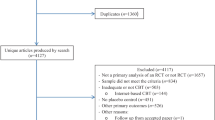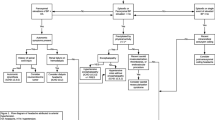Abstract
Chronic daily headache is a serious disease, causing significant problems in terms of reduced quality of life and disability, with pain localized to the head (headache) occurring 15 or more days per month for more than 3 months (>180 days per year). Drugs, both used as preventive medications or as pain-killers, are insufficient for the management of these patients; a more global approach has been advocated. This paper reviews existing data concerning different psychological approaches, with a focus on adolescence. This leads to evidence still unanswered questions but also the importance to include psychological treatments in the management of this potentially disabling condition.
Similar content being viewed by others
References
Papers of particular interest, published recently, have been highlighted as: • Of importance •• Of major importance
Antonaci F, Voiticovschi-Iosob C, Di Stefano AL, Galli F, Ozge A, Balottin U. The evolution of headache from childhood to adulthood: a review of the literature. J Headache Pain. 2014;15:15.
Mathew NT, Stubits E, Nigam MP. Transformation of episodic migraine into daily headache: analysis of factors. Headache. 1982;22(2):66–8.
Holden EW, Gladstein J, Trulsen M, Wall B. Chronic daily headache in children and adolescents. Headache. 1994;34(9):508–14.
Seshia SS, Wang SJ, Abu-Arafeh I, et al. Chronic daily headache in children and adolescents: a multi-faceted syndrome. Can J Neurol Sci. 2010;37(6):769–78.
Seshia SS. Chronic daily headache in children and adolescents. Curr Pain Headache Rep. 2012;16:60–72.
Headache Classification Committee of the International Headache Society (IHS). The International Classification of Headache Disorders, 3rd edition (beta version). Cephalalgia. 2013;33(9):629–808.
Wang SJ, Fuh JL, Lu SR, Juang KD. Chronic daily headache in adolescents: prevalence, impact and medication overuse. Neurology. 2006;66:193–7.
Arruda MA, Guidetti V, Galli F, Albuquerque RC, Bigal ME. Frequent headaches in the preadolescent pediatric population: a population-based study. Neurology. 2010;74(11):903–8.
Galli F, Caputi M, Gallucci M, Termine C, Chiappedi M, Balottin U et al. Headache and psychological disorders in children and adolescents: a cross-generational study. Minerva Pediatr. 2015.
Kröner-Herwig B. Pediatric headache: associated psychosocial factors and psychological treatment. Curr Pain Headache Rep. 2013;17(6):338.
Seshia SS, Phillips DF, von Baeyer CL. Childhood chronic daily headache: a biopsychosocial perspective. Dev Med Child Neurol. 2008;50(7):541–5.
Seshia SS. Chronic daily headache in children and adolescents. Can J Neurol Sci. 2004;31(3):319–23.
Lewis DW, Winner P, Wasiewski W. The placebo responder rate in children and adolescents. Headache. 2005;45(3):232–9.
Balottin U, Chiappedi M, Rossi M, Termine C, Nappi G. Childhood and adolescent migraine: a neuropsychiatric disorder? Med Hypotheses. 2011;76(6):778–81.
Piazza F, Chiappedi M, Maffioletti E, Galli F, Balottin U. Medication overuse headache in school-aged children: more common than expected? Headache. 2012;1506–1510. A prospective study exploring the prevalence of MOH in children seen in a third-level center.
Wang SJ, Fuh JL, Lu SR, Juang KD. Outcomes and predictors of chronic daily headache in adolescents: a 2-year longitudinal study. Neurology. 2007;97:739–54.
Chiappedi M, Balottin U. Medication overuse headache in children and adolescents. Curr Pain Headache Rep. 2014;18(4):404.
Bruffaerts R, Demyttenaere K, Kessler RC, et al. The associations between preexisting mental disorders and subsequent onset of chronic headaches: a worldwide epidemiologic perspective. J Pain. 2015;16(1):42–52. A study providing interesting and innovative find regarding the “what comes first” question between headache and psychopathology.
Blaauw BA, Dyb G, Hagen K, et al. The relationship of anxiety, depression and behavioral problems with recurrent headache in late adolescence—a Young-HUNT follow-up study. J Headache Pain. 2015;16:10.
Wang SJ, Juang KD, Fuh JL, Lu SR. Psychiatric comorbidity and suicide risk in adolescents with chronic daily headache. Neurology. 2007;68:1468–73.
Balottin U, Fusar Poli P, Termine C, Molteni S, Galli F. Psychopathological symptoms in child and adolescent migraine and tension-type headache: a meta-analysis. Cephalalgia. 2013;33(2):112–22.
Eccleston C, Palermo TM, Williams AC, Lewandowski A, Morley S. Psychological therapies for the management of chronic and recurrent pain in children and adolescents. Cochrane Database Syst Rev. 2009;2:CD003968.
Sieberg CB, Huguet A, von Baeyer CL, Seshia SS. Psychological interventions for headache in children and adolescents. Can J Neurol Sci. 2012;39:26–34. An interesting review of possible psychological interventions for headache in children and adolescents, although not focused only on CDH.
Trautmann E, Lackschewitz H, Kroner-Herwig B. Psychological treatment of recurrent headache in children and adolescents—a meta-analysis. Cephalalgia. 2006;26:1411–26.
Huguet A, McGrath PJ, Stinson J, Tougas ME, Doucette S. Efficacy of psychological treatment for headaches: an overview of systematic reviews and analysis of potential modifiers of treatment efficacy. Clin J Pain. 2014;30(4):353–69.
Guyuron B, Lineberry K, Nahabet EH. A retrospective review of the outcomes of migraine surgery in the adolescent population. Plast Reconstr Surg. 2015;135(6):1700–5.
Beck AT. Cognitive therapy: past, present, and future. J Consult Clin Psychol. 1993;61(2):194–8.
Eccleston C, Malleson PN, Clinch J, Connell H, Sourbut C. Chronic pain in adolescents: evaluation of a programme of interdisciplinary cognitive behaviour therapy. Arch Dis Child. 2003;88(10):881–5.
Gil KM, Anthony KK, Carson JW, Redding-Lallinger R, Daeschner CW, Ware RE. Daily coping practice predicts treatment effects in children with sickle cell disease. J Pediatr Psychol. 2001;26(3):163–73.
Holden EW, Deichmann MM, Levy JD. Empirically supported treatments in pediatric psychology: recurrent pediatric headache. J Pediatr Psychol. 1999;24(2):91–109.
Haddock CK, Rowan AB, Andrasik F, Wilson PG, Talcott GW, Stein RJ. Home-based behavioral treatments for chronic benign headache: a meta-analysis of controlled trials. Cephalalgia. 1997;17(2):113–8.
Andrasik F, Grazzi L, Usai S, D’Amico D, Leone M, Bussone G. Brief neurologist-administered behavioral treatment of pediatric episodic tension-type headache. Neurology. 2003;60(7):1215–6.
Napier DA, Miller CM, Andrasik F. Group treatment for recurrent headache. Adv Med Psychother. 1997–98;9:21–31.
Allen KD, Md S. Role of parent-mediated pain behavior management strategies in biofeedback treatment of childhood migraines. Behav Ther. 1998;29(3):477–90.
Fishman SM, Ballantyne JC, Rathmell JP. Bonica’s management of pain. Philadelphia: Lippincott Williams & Wilkins; 2009.
Sadler J. Pain relief without drugs: a self-help guide for chronic pain and trauma. Rochester: Healing Arts Press; 2007.
Warfield CA, Fausett HJ. Manual of pain menagement. Philadelphia: Lippincott Williams & Wilkins; 2002.
Corey D. Learning to live without it. Toronto: Macmillan Canada; 2004.
Emmen HH, Passchier J. Treatment of headache among children by progressive relaxation. Cephalalgia. 1987;7 Suppl 6:387–9.
Engel JM, Rapoff MA, Pressman AR. Long-term follow-up of relaxation training for pediatric headache disorders. Headache. 1992;32(3):152–6.
Palermo TM, Eccleston C, Lewandowski AS, Williams AC, Morley S. Randomized controlled trials of psychological therapies for management of chronic pain in children and adolescents: an updated meta-analytic review. Pain. 2010;148(3):387–97.
Reid GJ, McGrath PJ. Psychological treatments for migraine. Biomed Pharmacother. 1996;50(2):58–63.
Bussone G, Grazzi L, D’Amico D, Leone M, Andrasik F. Biofeedback-assisted relaxation training for young adolescents with tension-type headache: a controlled study. Cephalalgia. 1998;18(7):463–7.
Burke EJ, Andrasik F. Home- vs. clinic-based biofeedback treatment for pediatric migraine: results of treatment through one-year follow-up. Headache. 1989;29(7):434–40.
Grazzi L, Leone M, Frediani F, Bussone G. A therapeutic alternative for tension headache in children: treatment and 1-year follow-up results. Biofeedback Self Regul. 1990;15(1):1–6.
Allen KD, McKeen LR. Home-based multicomponent treatment of pediatric migraine. Headache. 1991;31(7):467–72.
Scharff L, Marcus DA, Masek BJ. A controlled study of minimal-contact thermal biofeedback treatment in children with migraine. J Pediatr Psychol. 2002;27(2):109–19.
Blume HK, Brockman LN, Breuner CC. Biofeedback therapy for pediatric headache: factors associated with response. Headache. 2012;52(9):1377–86.
Shiri S, Feintuch U, Weiss N, et al. A virtual reality system combined with biofeedback for treating pediatric chronic headache—a pilot study. Pain Med. 2013;14:621–7. An interesting and innovative approach to treatment of chronic headache in children.
Forsyth JP, Eifert GH. The mindfulness and acceptance workbook for anxiety. Oakland: New Harbinger Publications; 2008.
Zeidan F, Grant JA, Brown CA, McHaffie JG, Coghill RC. Mindfulness meditation-related pain relief: evidence for unique brain mechanisms in the regulation of pain. Neurosci Lett. 2012;520(2):165–73.
Kabat-Zinn J. An outpatient program in behavioral medicine for chronic pain patients based on the practice of mindfulness meditation: theoretical considerations and preliminary results. Gen Hosp Psychiatry. 1982;4(1):33–47.
Kabat-Zinn J, Lipworth L, Burney R. The clinical use of mindfulness meditation for the self-regulation of chronic pain. J Behav Med. 1985;8(2):163–90.
Hayes SC, Bissett RT, Korn Z, et al. The impact of acceptance versus control rationales on pain tolerance. Psychol Rec. 1999;49:33–47.
McCracken LM, Eccleston C. Coping or acceptance: what to do about chronic pain? Pain. 2003;105(1-2):197–204.
Wicksell RK, Melin L, Olsson GL. Exposure and acceptance in the rehabilitation of adolescents with idiopathic chronic pain—a pilot study. Eur J Pain. 2007;11(3):267–74.
Hayes SC, Luoma JB, Bond FW, Masuda A, Lillis J. Acceptance and commitment therapy: model, processes and outcomes. Behav Res Ther. 2006;44(1):1–25.
Kohen DP. Chronic daily headache: helping adolescents help themselves with self-hypnosis. Am J Clin Hypn. 2011;54(1):32–46.
Kohen DP. Long-term follow-up of self-hypnosis training for recurrent headaches: what the children say. Int J Clin Exp Hypn. 2010;58(4):417–32.
Anbar RD, Zoughbi GG. Relationship of headache-associated stressors and hypnosis therapy outcome in children: a retrospective chart review. Am J Clin Hypn. 2008;50(4):335–41.
Rogovik AL, Goldman RD. Hypnosis for treatment of pain in children. Can Fam Physician. 2007;53(5):823–5.
Plotnick AB, Payne PA, O’Grady DJ. Correlates of hypnotizability in children: absorption, vividness of imagery, fantasy play, and social desirability. Am J Clin Hypn. 1991;34(1):51–8.
Olness K, MacDonald JT, Uden DL. Comparison of self-hypnosis and propranolol in the treatment of juvenile classic migraine. Pediatrics. 1987;79(4):593–7.
Clarici A, Pellizzoni S, Guaschino S, et al. Intranasal administration of oxytocin in postnatal depression: implications for psychodynamic psychotherapy from a randomized double-blind pilot study. Front Psychol. 2015;6:426.
Balottin U, Ferri M, Racca M, et al. Psychotherapy versus usual care in pediatric migraine and tension-type headache: a single-blind controlled pilot study. Ital J Pediatr. 2014;40:6. One of the few studies exploring the possible role of psychodynamic psychotherapy in patients with headache.
Altieri M, Di Giambattista R, Di Clemente L, et al. Combined pharmacological and short-term psychodynamic psychotherapy for probable medication overuse headache: a pilot study. Cephalalgia. 2009;29(3):293–9.
Abbass A, Kisely S, Kroenke K. Short-term psychodynamic psychotherapy for somatic disorders. systematic review and meta-analysis of clinical trials. Psychother Psychosom. 2009;78(5):265–74.
Grandi A, Mazzola M, Angelini L, Chiappedi M. Listening to the patient as a possible route to cost-effective rehabilitation: a case report. J Med Case Rep. 2012;6:19.
Chiappedi M, Baschenis IM, Dolci R, Bejor M. Importance of a critical reading of neuropsychological testing. Minerva Pediatr. 2011;63(3):239–45.
Chiappedi M, Maltagliati S, Amoruso A, Dolci R, Carniglia C, Bejor M. Child rehabilitation refusal: why it happens and possible strategies to avoid it. Eur J Phys Rehabil Med. 2009;45(4):487–92.
Chiappedi M, Panizzari C, Bejor M. Rehabilitative treatment refusal and socio-economic status: a complex relationship. Child Care Health Dev. 2011;37(2):302–3.
Diener HC, Gaul C, Jensen R, et al. Integrated headache care. Cephalalgia. 2011;31(9):1039–47.
Fearon P, Hotopf M. Relation between headache in childhood and physical and psychiatric symptoms in adulthood: national birth cohort study. BMJ. 2001;322:1145.
Author information
Authors and Affiliations
Corresponding author
Ethics declarations
Conflict of Interest
Matteo Chiappedi, Martina Maria Mensi, Cristiano Termine, and Umberto Balottin declare that they have no conflict of interest.
Human and Animal Rights and Informed Consent
This article does not contain any studies with human or animal subjects performed by any of the authors.
Additional information
This article is part of the Topical Collection on Chronic Daily Headache
Rights and permissions
About this article
Cite this article
Chiappedi, M., Mensi, M.M., Termine, C. et al. Psychological Therapy in Adolescents with Chronic Daily Headache. Curr Pain Headache Rep 20, 3 (2016). https://doi.org/10.1007/s11916-015-0532-x
Published:
DOI: https://doi.org/10.1007/s11916-015-0532-x




